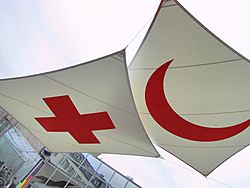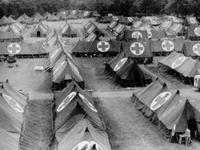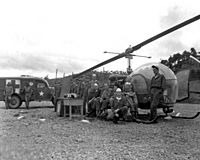Field hospital facts for kids
A field hospital is a small, moving medical place that helps injured people close to where fighting is happening, or near a disaster area. The World Health Organization says a field hospital is a mobile health center that can be quickly set up or taken down. It can also grow or shrink to fit the immediate needs during an emergency. Treating wounds from war has been done for a very long time. The term "field hospital" is mostly used in the military.
Contents
History of Field Hospitals
Ancient Times
People have always tried to help wounded soldiers by taking them off the battlefield and caring for them. They would take them to temporary shelters and give them the best care they knew at the time.
In the ancient Greek story, the Iliad, there's a short mention of Machaon and Podalirius. These are some of the first times we hear about field surgeons who helped soldiers. The ancient Greeks and Romans used nearby houses, stables, and temples as field hospitals. Even back then, Romans knew that good drainage and sewage systems helped keep these places clean. This helped injured soldiers get better faster.
Middle Ages
After the Crusades, many men came back hurt, blind, or sick. The Church created special groups, called religious orders, to care for them. One famous group was the Knights Hospitaller. They set up field hospitals in Jerusalem and Acre from 1120 to 1291.
Medieval Spain was quite advanced in battlefield medicine. When Spanish armies went to war, doctors and surgeons went with them. By the 1200s, hospitals in Spain started to organize patients into different areas. They separated them by gender, type of sickness, or injury. During the war to take back Granada, Queen Isabella of Castile even set up ambulances and field hospitals for her soldiers.
Early Modern Period
By the late 1700s, France started to notice how bad their hospitals were. For example, the Hôtel-Dieu hospital in Paris was full of sickness and pests. It had about 1,220 beds, but up to six patients often shared one bed! Others lay on straw in dirty hallways. Doctors had to hold sponges soaked in vinegar over their faces because of the terrible smell. In 1788, French scientists suggested ways to make hospitals cleaner and have better air flow. They said rooms should be a certain size, have 34 to 36 beds, and have windows from floor to ceiling.
Field hospitals during the time of Napoleon were very basic. People didn't know about hygiene (keeping things clean), and antibiotics hadn't been discovered yet. Cutting off a limb (amputation) was the most common way to treat wounds. Soldiers sometimes waited for days to be taken off the battlefield. They had no water or food, and flies bothered them as they bled. Many died from infection before getting any medical help. If they were rescued, they went to temporary surgical places. There, overworked surgeons did their best. In these "field hospitals," soldiers had to have amputations without any pain medicine. Officers sometimes got rum or brandy, while regular soldiers were given a piece of wood to bite on. The chances of surviving their wounds were very low.
American Civil War
By 1861, medical knowledge and equipment were still very basic. Treating wounds, infections, and diseases often made things worse. Doctors didn't understand what caused infections and couldn't do much to treat them. It's believed that twice as many soldiers died from disease as from gunshot wounds. Camp hygiene was terrible. Poor toilets, lack of shelter, clothes, shoes, and food all led to many deaths in the camps. Prisoners of war lived in the worst conditions. Dysentery (a severe stomach illness) was very common because of bad sanitation and dirty water. Doctors didn't wash their tools or their hands when moving from patient to patient. Nurses who cared for the sick also risked catching diseases themselves. With the simple medicine of the time, most diseases could be deadly. While medical knowledge slowly got better during the war, it wasn't enough to save thousands of lives.
Twentieth Century Field Hospitals
In World War I, the U.S. Army used "evacuation hospitals" to get soldiers care quickly. Medical soldiers called stretcher bearers carried the wounded off the field. They first went to a Battalion Aid Station, where medics gave basic first aid. For more serious injuries, ambulances took the wounded to a field hospital. At the field hospital, they went through a process called triage. This meant sorting patients by how serious their wounds were. Soldiers exposed to poison gas went to special hospitals. After triage, they went to evacuation hospitals for surgery and recovery. Then, they moved to base hospitals for more care and rest. World War I was the first time the army tried using mobile hospitals.
During World War II, the field hospitals used by the Allies were mobile. They usually had about 400 beds. The more permanent evacuation hospitals could have 400 or 750 beds. Mobile hospitals would arrive within days after an invasion. They would move with the armies, staying a few miles behind the front lines. They often used canvas tents but would also use any available buildings. When a field hospital was about to move, they stopped taking new patients. They sent the ones they had to other hospitals. Then, they packed their tents and equipment onto trucks and moved to the new spot. Within a few hours, they were ready to help wounded soldiers again.
German field hospitals in World War II were similar to those of the U.S. Army. However, their triage process was different. First aid was given at a verwundetennest by army medics. These were very close to the battlefield. Wounded soldiers then went to an aid station where a doctor saw them. After that, stable patients went to a clearing station. This was about 4 miles from the front line and usually had two doctors. They could care for about 200 patients. If a soldier had a serious wound, they had surgery there. More serious cases, like severe bone breaks or brain injuries, were sent to a larger military hospital.
Modern Field Hospitals
In the United States, there are over 75 military hospitals and 461 clinics. They treat military people and their families. In emergencies, they also help regular citizens. Another example is Israel. The Israel Defense Forces can set up a field hospital within 12 hours of arriving somewhere. This happens when local hospitals are too busy or not working. These are two examples of modern military field hospitals that serve a double purpose.
For countries hit by natural disasters, many already have most of the supplies they need. This is different from what the news often says. Sometimes, well-meaning people send donations to places that don't really need them. Also, field hospitals already in a country can usually be set up much faster than waiting for other countries to send them. For countries that don't have these resources, field hospitals are one of the most important things they want to have for emergencies.
Modern field hospitals have changed a lot. They are no longer just canvas tents. They are now modern, well-equipped health centers. Many are still made of fabric, but they are designed to be clean, safe, and comfortable. They can move easily and are found in almost all parts of the world. They can be small, single-room shelters or large hospitals with 200 or more beds. They offer all kinds of medical care. Modern field hospitals might have emergency rooms, intensive care units, and outpatient clinics. They provide everything from first aid to mental health care and ways to prevent sickness.
Sometimes, international disaster help is slowed down more by politics than by a lack of equipment or people. The country that is affected, international groups like the United Nations, non-profit groups, or the country offering help can cause delays. Often, the needs of the organization or government come first. Ideally, experts should quickly figure out what help is needed. Then, the help should be given based on people's needs, not political reasons.
Field Hospitals and the Law

Under international humanitarian law, hospitals of any kind have special protection. It is a war crime to purposely attack a hospital or any medical unit. It is also against the rules to use a hospital or medical building as part of a military action. For example, you cannot use a hospital as a fort. It is also against international law to use a hospital, ambulance, or any medical facility to hide soldiers who are not wounded.
Besides international law, the laws of all nations protect hospitals and medical staff. This has been a basic part of international law since 1864. It is also part of the four Geneva Conventions of 1949 and was updated in 1977. Doctors, nurses, and medical staff must treat the sick and wounded in a war zone. Attacking them or the hospitals they work in is a crime.
International law protects medical staff to make sure they are not stopped by military actions. They must treat patients based only on their medical needs. They cannot be forced to treat one side more than the other. Medical staff cannot be punished for doing their medical work, no matter who the patient is. They also cannot share private patient information. All hospital staff must stay neutral and ethical at all times. They cannot take sides in a war or fight. Medical units must collect all weapons at the entrance and store them until the patient leaves.
If enemy soldiers capture the area where hospitals or mobile medical places are, medical staff can still be taken. However, the medical team and the patients (from either side) must be treated with respect. They must be allowed to do their normal jobs of caring for the sick and wounded. In international conflicts, permanent medical staff must be sent back to their home country. This is unless their help is needed for a short time to care for their patients. Permanent medical staff are those assigned to a medical job for the whole conflict. Temporary staff might be taken prisoner, and their medical skills can be used while they are held. If a conflict is not international, there is no difference between permanent and temporary medical staff. But in no case can medical staff be punished for caring for sick and wounded enemy soldiers.
Images for kids
See also
 In Spanish: Hospital de campaña para niños
In Spanish: Hospital de campaña para niños










